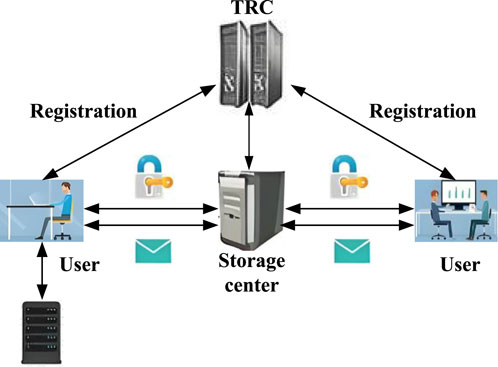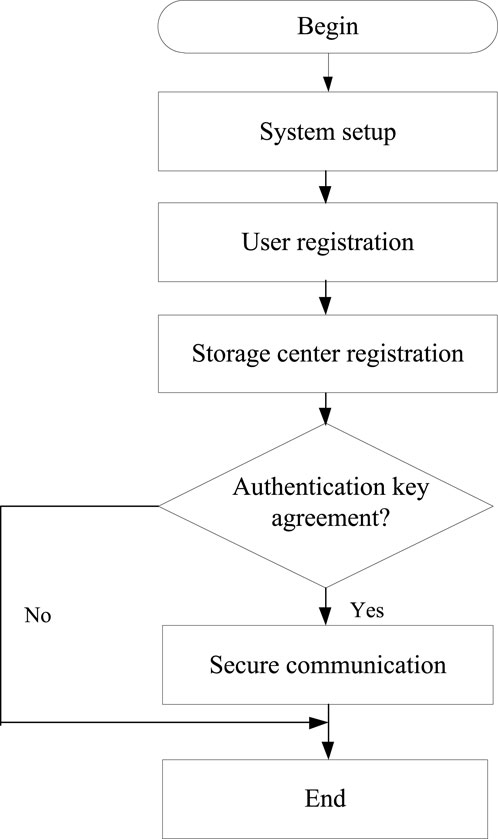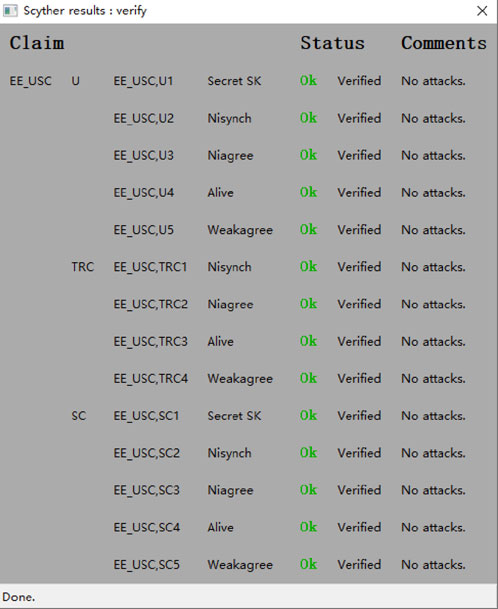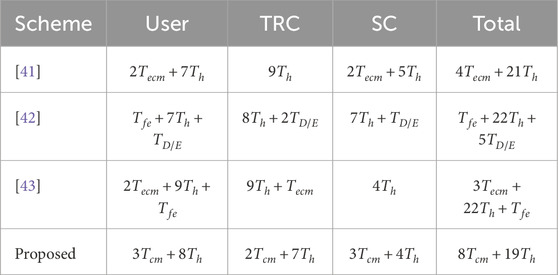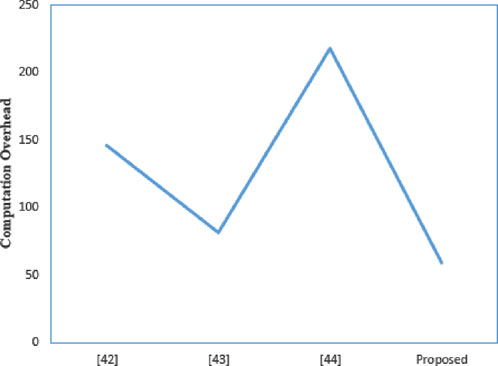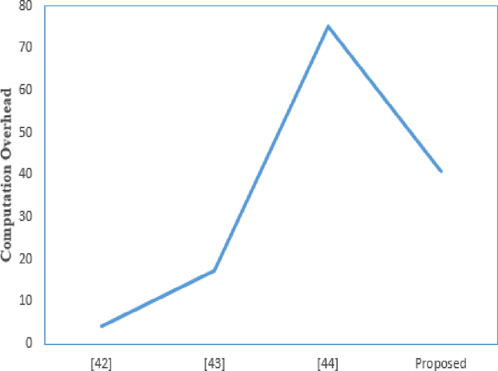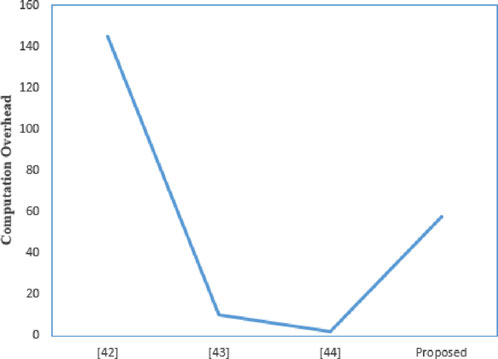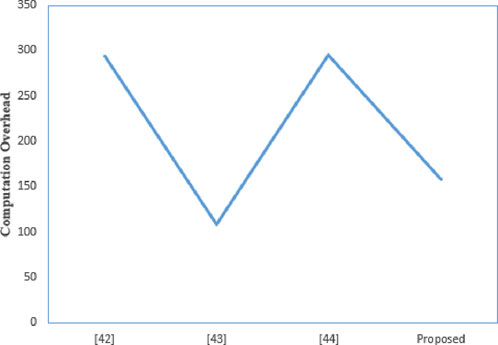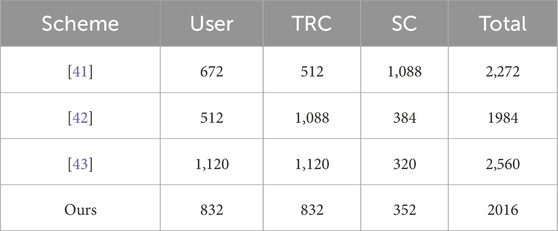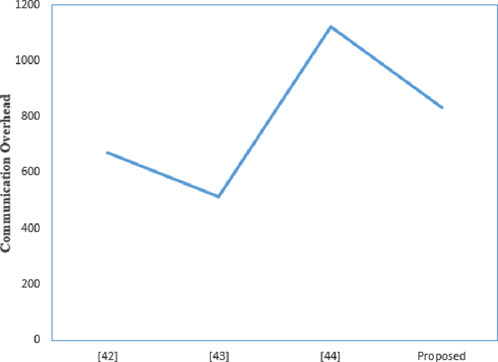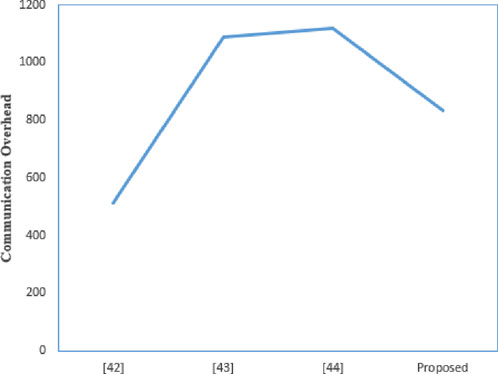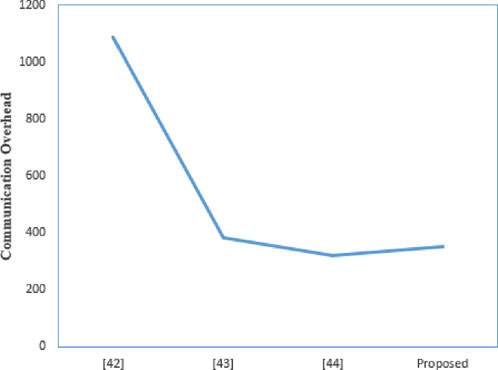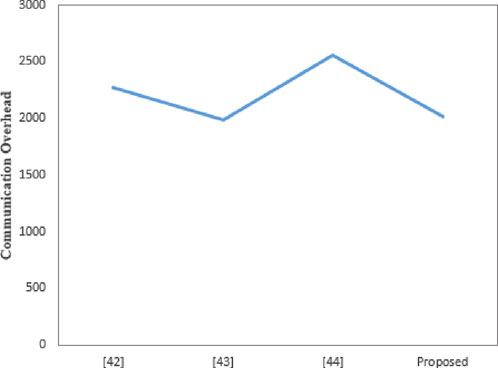- College of Criminal Investigation, People’s Public Security University of China, Beijing, China
With the rapid development of information technology, Internet of Things (IoT) is profoundly impacting various fields of the socio-economic landscape, driving the transformation of traditional industries towards intelligence. However, the widespread application of IoT has also led to a surge in electronic evidence, whose importance in the judicial field is increasingly prominent, but its characteristics such as ease of replication and leakage have posed new challenges for privacy protection. This paper focuses on the security and privacy issues of electronic evidence in IoT and proposes an efficient and secure interaction scheme based on chebyshev chaotic map, hash functions and XOR operations. Through a secure two-factor authentication mechanism, this scheme achieves identity verification between the user and the storage center, as well as confidentiality during the data transmission process. This has significant implications for the healthy development of IoT, judicial fairness and personal privacy protection. Experimental and theoretical analysis shows that the proposed scheme not only effectively resists various known attacks, but also performs excellently in terms of communication and computation costs, making it well-suited for IoT.
Highlights
• A secure authentication scheme is designed for electronic evidence transmission in IoT.
• Security analysis shows that the scheme provides enhanced security.
• The scheme exhibits higher computational efficiency and lower overhead.
1 Introduction
In recent years, Internet of Things (IoT) has become an important driving force for the development of modern science and technology [1]. IoT integrates various information sensing devices with the Internet through intelligent sensing, identification technologies, and pervasive computing, forming a vast network that connects objects, thereby enabling efficient information exchange between people and objects, as well as between objects themselves [2]. However, with the widespread adoption of IoT applications, the volume of electronic evidence generated has also grown exponentially. The vast amount of electronic evidence data is increasingly valuable and useful [3]. In the judicial field, electronic data has increasingly been used in recent years as a new form of evidence to prove the facts of a case. The concept of electronic evidence has emerged, and the perception of judicial proof is gradually changing [4]. Electronic evidence, which is generated by the application of electronic information technology and can be used to prove case facts, includes electronic materials and their derivatives. Due to its characteristics of easy collection, convenient preservation, efficient transmission, and small space requirements, electronic evidence has gradually gained importance in the judiciary and, in many cases, carries the same legal weight as traditional evidence [5]. The extensive use of electronic evidence in the digitization of the legal system has gradually revealed its inherent flaws and limitations, which are becoming increasingly influential. First, electronic evidence can appear in multimedia forms such as text, images, audio, and video, which places higher demands on storage, extraction, and identification methods. Additionally, electronic evidence exists in the non-continuous form of binary code, and its transmission and storage rely on computer technology and specialized equipment. Non-experts find it difficult to identify and examine such evidence. If the transmission medium or storage device is compromised, the integrity of the electronic evidence may be altered, resulting in a loss of evidentiary value. Finally, in all stages of electronic evidence collection, identification, storage, and application, it is susceptible to tampering due to computer errors, virus attacks, or deliberate technical manipulation. This process is difficult to detect or trace, which directly compromises the authenticity of the electronic evidence [6–9].
Meanwhile, the privacy issues related to electronic evidence are receiving increasing attention. As electronic evidence, in its digital form, is easily replicated, accessed, and leaked, it often contains private information of states, enterprises, and individuals, whose disclosure would lead to privacy security issues [10–12]. The privacy issues associated with electronic evidence are of significant importance to both the state and the general public.
On the other hand, since electronic evidence is a form of electronic data, its transmission, download, and upload processes are easily executed. However, the flow of this data is difficult to record, making it challenging to trace the entities involved and the sequence of its transfer. Critical information such as the entity handling the electronic evidence and the time of operation is often unobtainable. Once a privacy breach occurs during the transfer of electronic evidence, it becomes difficult to trace the specific stage at which the breach happened, complicating accountability and posing significant challenges to privacy protection [13–15]. In this context, it is crucial to implement identity verification between users and storage centers while ensuring secure communication between nodes. A feasible security solution is to deploy an authenticated key agreement scheme, which verifies the true identity of communicating entities before sharing any sensitive information over unsecured wireless channels [16–18]. Mutual authentication can be used to verify the true identity of communication participants before transmitting data, eliminating the need to send sensitive information over unsecured channels. After participants have mutually confirmed their identities, the AKA scheme can negotiate a shared session key to encrypt subsequent transmission messages. Therefore, users and storage centers can authenticate each other, allowing only users with the session key to access the collected electronic evidence, while unauthorized users cannot. Researching efficient and secure interaction schemes for electronic evidence in IoT is of great significance for promoting the healthy development of IoT technology, upholding judicial fairness, and protecting personal privacy. Therefore, this paper proposes an efficient and secure interaction scheme for electronic evidence in the IoT. This scheme achieves rapid authentication of entity identity and ensures confidentiality during data transmission. This scheme not only has provable security and can resist various mentioned attacks, but it is also suitable for IoT environments with limited resources and energy, offering lower computational and communication overhead. Our contributions are as follows:
(1) A secure two-factor authentication scheme is designed for the security of electronic evidence transmission in IoT. The scheme employs a pseudonym mechanism, hiding the pseudonym within the transmission message to achieve user identity anonymity and ensure identity security. Additionally, chebyshev chaotic map, hash functions and XOR operations are utilized to complete identity authentication between users and storage centers, achieving strong authentication security and scalability.
(2) The proposed scheme satisfies security under formal proof, also meeting mutual authentication security and key agreement security. Informal security analysis shows that the scheme provides enhanced security, and resists various known attacks such as man-in-the-middle attacks and impersonation attacks.
(3) In terms of costs, the scheme exhibits higher computational efficiency and lower overhead compared to other schemes.
The organization of the rest is as follows. A comprehensive summary of existing researches in the relevant field are conducted in Section 2. In Sections 3, 4, the fundamental theoretical framework supporting the proposed scheme is thoroughly explained and the specific details of the scheme are introduced. In Section 5, we conducted the proposed scheme. Section 6 presents the performance experiments. Section 7 concludes the paper.
2 Related work
Identity authentication is one of the most crucial components in IoT systems, especially in wireless networks, where it is indispensable. This function prevents security issues such as data theft and identity spoofing. Many researchers have proposed their own security schemes for IoT identity authentication. Table 1 shows a comparative analysis of relevant protocols.
Sandeep et al. [19] presented a protocol for multi-server architectures. However, it fails to resist impersonation attacks and stolen smart card attacks. Butun et al. [20] designed a cloud-centric multi-layer framework. The entities included users, wearable devices, wearable device network coordinators and cloud service providers. It then provided multi-level authentication, such as authentication between users and cloud service providers, between cloud service providers and wearable device network coordinators and between wearable network coordinators and wearable devices. The scheme used the digital signature and identity authentication between cloud service providers and users. The algorithm is used during the initialization phase for negotiating the key for the message authentication code algorithm between different entities. The algorithm was used to compute the hash authentication code of data packets between entities. The extensive use of digital certificate signature algorithms and multi-tier key agreement algorithms in this scheme results in excessive computational overhead. Furthermore, the identity authentication method relied on an authentication chain, which, if disrupted at any stage, can cause the entire authentication process to fail. Ramos et al. [21] proposed a method for point and field algorithms, designed to implement access control mechanisms based on security and functionality in smart objects. Shen et al. [22] focused on efficient multi-layer authentication protocols. First, the authors proposed a group protocol. Then, the authors proposed a certificate-less authentication protocol between the personal digital assistant and application providers. In these protocols, elliptic encryption algorithms offer low computational overhead and high security. However, the excessive use of point multiplication calculations in this scheme introduces significant computational overhead. Additionally, the lack of consideration for timestamps in each data packet transmission makes it vulnerable to replay attacks. Shen et al. [23] described a lightweight and cloud-assisted protocol. During the registration phase, the user and the central server send the hash value of their device ID to the network administrator, who then uses an elliptic curve algorithm to select a random number to compute the public key for the corresponding entity. The network administrator also provides a signature value using their private key and the corresponding ID’s hash value to the entity. This achieves entity identity authentication while protecting the entity’s ID from being disclosed, thus enabling secure anonymous authentication in the protocol. However, the scheme’s use of multiple signature algorithms increases computational overhead and fails to resist replay attacks. Gope et al. [24] described a lightweight real-time protocol for anonymous identity verification. It guarantees anonymity and ensures both forward and backward data confidentiality. However, it uses an excessive number of hash functions, making its authentication more susceptible to attacks compared to other methods. Similarly, Chifor et al. [25] proposed a scheme. The scheme utilizes the existing mobile authentication framework to achieve fast and convenient entity identity verification. However, this scheme simply leverages an existing open-source framework and its corresponding APIs for specific user authentication and authorization, rather than being a genuinely lightweight solution.
Encrypting transmitted data using a secure shared key is an effective method for establishing a secure communication channel. The secure distribution of the shared key is crucial, and key agreement is an effective way to address key distribution. However, as the sensor devices in IoT rapidly increases on a large scale, it presents greater challenges for secure transmission in the IoT context. Zheng et al. [26] presented a group key management scheme, which has the advantage of minimizing parameter broadcasts. However, the computational complexity of key calculations on the user side is too high. In the same year, Guo et al. [27] presented a secure data scheme. In this scheme, a single public key is linked to multiple groups of private keys, making it easy for attackers to identify the group sending the message but difficult to trace the sender’s specific message. Lin et al. [28] presented a scheme based on ordered message authentication. In this scheme, a vehicle first sends a hash chain to nearby vehicles, which then generate message authentication codes based on elements of the hash chain. Nearby vehicles can use this information to authenticate the sender. However, due to the need for the sender to frequently broadcast its hash chain in large-scale networks, the packet loss rate in this scheme significantly increases. In recent years, the transmission efficiency and security of devices in the IoT environment have garnered widespread attention. Vijayakumar et al. [29] proposed a data security transmission protocol. The protocol used bidirectional authentication to ensure identity verification and employed a group key algorithm for key agreement. However, this scheme required re-negotiating the group key every time a user joins or leaves, which incurs a certain computation overhead on the secure transmission of the entire model. Sanaz et al. [30] presented a scheme within the context of mobile smart healthcare networks. This scheme achieved secure and efficient identity authentication and authorization for end users. It incorporates a key renegotiation mechanism, which reuses previous parameters to save on the cost of parameter negotiation, while the cross-regional transition mechanism effectively addresses the issue of patient identity authentication during spatial movements. However, because it is a traditional communication protocol that uses certificate mechanisms for identity authentication, it results in significant computational overhead, making it unsuitable for smart home environments. Tarun et al. [31] demonstrated through capability and performance analysis that ECDH is more suitable for IoT. The authors tested the time required for ECDH and RSA encryption and decryption using specific code, and conducted detailed energy consumption analyses using industry-standard test suites. They also made precise comparisons with other algorithms and ultimately applied the ECDH scheme to image encryption. Song et al. [32] described an improved protocol for IoT devices. This protocol employs a dual-key encryption mechanism, with one key used for plaintext encryption and another for computing MAC. The shared encryption key and MAC key are generated by a chaotic logistic map system. Instead of using a device authentication code mechanism for identity authentication, this scheme relies on a simple MAC-based approach. The mechanism adopted in this scheme is a one-time pad, where each data encryption is accompanied by a transmission round number. Although a one-time pad significantly enhances data security, it also introduces the problem of transmission round number desynchronization, leading to decryption confusion in the smart home transmission scheme, which could be a critical issue. Shen et al. [33] focused on secure data uploading. They proposed an improved scheme, which ensured the integrity of cloud-verified data while preventing data theft and modification by malicious home gateways. Rathore et al. [34] proposed a high-speed real-time scheme. The scheme is divided into four stages: registration, key exchange, key revocation, and data transmission. Although the scheme achieves real-time high-speed data transmission with careful consideration of details like timestamps, it employs a large number of signature algorithms and asymmetric encryption algorithms to ensure data integrity, data identity authentication, and secure key agreement. This results in high computational overhead for the entire smart city system. Hui et al. [35] proposed a novel data transmission scheme for Industrial IoT, based on a chaotic system and utilizing a linear n-shift encryption mechanism, which also includes a synchronization mechanism. However, this scheme lacks a reliable key update mechanism, making it vulnerable to ciphertext analysis attacks.
3 Preliminaries
3.1 Model
This paper delves into the secure interaction mechanisms for electronic evidence, with the core objective of ensuring the privacy and security of electronic evidence during its transfer, thereby upholding the dual requirements of judicial fairness and data protection. As shown in Figure 1, this electronic evidence interaction model is meticulously constructed and consists of three core components: the trust registration center (TRC), user, the storage center.
As the cornerstone of the model, TRC acts as a trusted third party. Its primary responsibility is system initialization, including generating the necessary security parameters and related configurations, laying a solid foundation for subsequent secure interactions. Additionally, TRC is responsible for the registration management of users and storage centers, ensuring that only legitimate and trusted entities can join the system through rigorous identity verification processes. In the electronic evidence interaction model, the user base is extensive and diverse, encompassing key judicial and law enforcement agencies such as courts, public security departments, procuratorates, forensic identification centers, arbitration committees, and notary offices. These users not only perform core operations such as uploading, forwarding, downloading, and reviewing evidence within the model but also ensure the legality and validity of the electronic evidence transfer through their expertise and authority. Notably, when interacting with the storage center, users, with the assistance of the TRA, use the key agreement mechanism to jointly generate a shared session key with the storage center. This key is used to encrypt all subsequent communications, ensuring the confidentiality and integrity of data transmission.
As the centralized platform for storing and managing electronic evidence, the storage center plays a crucial role. It stores the received electronic evidence to prevent unauthorized access and tampering. The storage center also enforces strict access control policies, precisely regulating user access to electronic evidence based on their permissions and identity. Additionally, to mitigate the risks of potential data loss or damage, the storage center employs strategies such as multi-replica storage, regular backups, and disaster recovery, ensuring high availability and durability of electronic evidence data. When providing upload and download services to users, the storage center uses the session key previously negotiated with the user to encrypt and decrypt the transmitted data, thus achieving secure end-to-end interaction.
In our security model, we assume that the TRC is a trusted entity with sufficient computational power to resist various known security attacks. TRC communicates with other entities through wired or secure channels and does not exhibit malicious behavior towards users during the registration process. The storage center is assumed to be a semi-trusted entity, meaning it is curious about the user’s privacy and is motivated to obtain it, but it will not conduct malicious attacks and will adhere to the protocol to execute the corresponding operations. The user is assumed to communicate with the storage center via an insecure wireless channel, which may be subject to various network security attacks from attackers. We consider the user to be an untrusted entity, meaning there may be malicious entities, such as compromised electric vehicles, that could carry out tampering, replay, delay, and other network security attacks on the system.
3.2 Chebyshev chaotic map
In this scheme, we employ an extended Chebyshev polynomial with enhanced security [36]. It is defined as follows:
Definition 1. Let n be an integer and
Zhang [37] demonstrated that the semigroup property of chebyshev polynomials also holds.
Definition 2. (Chaotic Map-Based Diffie-Hellman Problem (CMBDHP)): Given x,
4 Proposed protocol
This paper proposes an interaction scheme for electronic evidence in IoT. Figure 2 shows the authentication flow.
4.1 System setup phase
At this stage, TRC generates its master private key and other public system parameters.
1. TRC selects a large prime number p and a hash function
2. TRC securely and confidentially stores the private key s, and publicly releases the system parameters
4.2 User registration
1.
2. Upon receiving
3. Upon receiving the response message
4.3 Storage center registration
1.
2. Upon receiving
3. Upon receiving the response message
4.4 Authentication key agreement phase
1. As shown in Figure 3,
2. Upon receiving the authentication request message
TRC further computes the verification message
TRC verifies the correctness of the message
3. Upon receiving the message
4.
5. Upon receiving
Then,
If the message passes verification,
5 Security evaluation
5.1 Formal security analysis
Before conducting a formal safety analysis of the proposed protocol, we propose an appropriate safety model [38, 39]. First, we define three participants in the proposed protocol: U, TRC and SC. In addition,
5.1.1 Session key security
It defines allowing an attacker
Theorem 1. Suppose
Prove: we proved it by playing four games,
Once all the queries are made by
According to the formulas, we can get Formula 9:
Based on the above proof,
5.2 Scyther tool analysis
Scyther is a protocol security analysis and verification tool [16]. This tool can use the Dolev-Yao attacker model and a strong security model to detect attack paths, which are illustrated graphically when found. To standardize the description of protocols and their security properties, Scyther provides a specialized description language called SPDL [40]. The following verification will utilize the Scyther tool and the Dolev-Yao attacker model.
In the protocol modeling of this paper, three roles are defined: U, TRC and SC, representing the tag, reader, and server, respectively. Secret, Alive, Weakagree, Niagree, and Nisynch are used to detect secret leakage, replay attacks and desynchronization attacks, respectively. The analysis results show that the Scyther tool could not identify any malicious attacks against the protocol presented in this paper, indicating that the protocol ensures the security of the secret information among the user, the trusted registration center, and the storage center. The Scyther tool analysis results are shown in Figure 4.
5.3 Informal analysis
5.3.1 User anonymity and untraceability
In the proposed scheme, on the one hand, no identity information is transmitted over the public channel. On the other hand, even if an attacker captures all the transmission information on the public channel, we use temporary identities for transmission, encrypted by
5.3.2 Privileged insider attack
Suppose a privileged insider becomes an attacker after obtaining the registration information of a legitimate user. Since the user’s password is protected by secret values and hash functions, the privileged insider cannot obtain the plaintext of the user’s password and cannot impersonate any party in the protocol.
5.3.3 User impersonation attack
To impersonate a legitimate
5.3.4 Storage center impersonation attack
Since
5.3.5 Replay attack
The scheme uses random numbers and timestamps to defend against replay attacks. Suppose an attacker attempts to replay request messages
5.3.6 Man-in-the-middle attack
Suppose an attacker attempts to intercept and tamper with messages
5.3.7 Mutual authentication
In the proposed scheme, to authenticate
5.3.8 Forward security
The session key ultimately negotiated in the proposed scheme,
5.3.9 Session key security
Only legitimate
6 Performance analysis
6.1 Computation overhead comparison
Table 2 summarizes the computation overhead of several protocols, where
According to the proposed scheme, the time cost for user authentication is
6.2 Communication overhead comparison
The communication overhead is shown in Table 3. The proposed scheme uses a 160-bit chebyshev chaotic map, a 160-bit random number, a 160-bit identity identifier, 128-bit symmetric encryption/decryption, 160-bit hash value, and a 32-bit timestamp. The three messages transmitted in this scheme are
While meeting more security performance and resistance to attacks, the communication overhead for some nodes in this scheme is slightly higher than that of other nodes. First, Chang [41] and Wazid [42]do not support resistance to password guessing attacks, so the user’s communication overhead is slightly lower than that of the proposed scheme. In order to implement this function, this consumes more communication overhead. Additionally, the proposed scheme has slightly higher communication overhead than Wazid [42]. However, Chang [41] does not support the safety requirement. Figures 9–12 visually illustrate the communication consumption of each scheme on different entities. Compared to other schemes, the communication overhead is lower. Therefore, the scheme in this article meets the practical needs of electronic evidence interaction in IoT.
7 Conclusion
This paper provides an in-depth analysis of the security and privacy issues surrounding electronic evidence in IoT. It highlights that the importance of electronic evidence in the judicial field is increasing, but its inherent vulnerabilities also pose significant privacy risks. To address this issue, this paper proposes a secure interaction scheme for electronic evidence in IoT. This scheme innovatively combines chebyshev chaotic map, hash functions and XOR operations to ensure the security of the electronic evidence transmission process. The scheme was then subjected to a security analysis using the random oracle model and the Scyther, proving its resilience against various types of attacks. Furthermore, the security analysis and performance experiment results demonstrate that the scheme optimizes authentication efficiency while ensuring security. This research not only offers new insights and methods for the secure management of electronic evidence in IoT environments but also makes a positive contribution to the healthy development of IoT technology, the maintenance of judicial fairness, and the protection of personal privacy. In the practical application, with numerous IoT devices and frequent data exchange, security risks also increase. The secure interaction scheme proposed in this paper can be applied to IoT security monitoring and management systems, achieving comprehensive monitoring and protection of device identity, data transmission, and storage processes, thereby improving the overall security of IoT systems.
Data availability statement
The original contributions presented in the study are included in the article/supplementary material, further inquiries can be directed to the corresponding author.
Author contributions
YX: Conceptualization, Data curation, Formal Analysis, Investigation, Methodology, Project administration, Software, Supervision, Writing–original draft, Writing–review and editing. LC: Formal Analysis, Investigation, Methodology, Resources, Validation, Visualization, Writing–review and editing.
Funding
The author(s) declare that financial support was received for the research, authorship, and/or publication of this article. The authors acknowledge funding received from the following science foundations: Research on the basic theory and methodology of data investigation (2023JKF01SK08).
Conflict of interest
The authors declare that the research was conducted in the absence of any commercial or financial relationships that could be construed as a potential conflict of interest.
Generative AI statement
The author(s) declare that no Generative AI was used in the creation of this manuscript.
Publisher’s note
All claims expressed in this article are solely those of the authors and do not necessarily represent those of their affiliated organizations, or those of the publisher, the editors and the reviewers. Any product that may be evaluated in this article, or claim that may be made by its manufacturer, is not guaranteed or endorsed by the publisher.
References
1. Nassereddine M, Khang A. Applications of internet of things (IoT) in smart cities. Adv IoT Tech Appl industry 4.0 digital economy (2024) 109–36.
2. Salam A. Internet of things for sustainability: perspectives in privacy, cybersecurity, and future trends. Internet things Sustain Community Dev wireless Commun sensing, Syst (2024) 299–326. doi:10.1007/978-3-031-62162-8_10
3. Quick D, Choo K-KR. Big forensic data reduction: digital forensic images and electronic evidence. Cluster Comput (2016) 19:723–40. doi:10.1007/s10586-016-0553-1
4. Arshad H, Bin Jantan A, Abiodun OI. Digital forensics: review of issues in scientific validation of digital evidence. J Inf Process Syst (2018) 14(2):346–76. doi:10.3745/JIPS.03.0095
5. Losavio M, Adams J, Rogers M. Gap analysis: judicial experience and perceptionof electronic evidence. J Digital Forensic Pract (2006) 1(1):13–7. doi:10.1080/15567280500541462
6. Sin JM, Son HR. Dealing with the problem of collection and analysis of electronic evidence. Int J Electron security digital forensics (2019) 11(3):363–77. doi:10.1504/ijesdf.2019.100497
7. Chen J, Li T, Zhang Y, You T, Lu Y, Tiwari P, et al. Global-and-Local attention-based reinforcement learning for cooperative behaviour control of multiple UAVs. IEEE Trans Vehicular Technology (2024) 73(3):4194–206. doi:10.1109/tvt.2023.3327571
8. Li H, Cao H, Feng Y, Li X, Pei J. Optimization of graph clustering inspired by dynamic belief systems. IEEE Trans Knowledge Data Eng (2024) 36(11):6773–85. doi:10.1109/tkde.2023.3274547
9. Li HJ, Feng Y, Xia C, Cao J. Overlapping graph clustering in attributed networks via generalized cluster potential game. ACM Trans Knowledge Discov Data (2024) 18(1):1–26. doi:10.1145/3597436
10. Xiong Y, Du J. Electronic evidence preservation model based on blockchain. In: the 3rd International Conference on Cryptography, Security and Privacy (ICCSP’19) (2019). p. 1–5. doi:10.1145/3309074.3309075
11. Chen Y, Li M, Qiu Y. A study on the current status of electronic evidence preservation in internet crime. J Educ Humanities Social Sci (2024) 28:541–8. doi:10.54097/reykxj59
12. Li HJ, Song S, Tan W, Huang Z, Li X, Xu W, et al. Characterizing the fuzzy community structure in link graph via the likelihood optimization. Neurocomputing (2022) 512:482–93. doi:10.1016/j.neucom.2022.09.013
13. Xiao N, Wang Z, Sun X, Miao J. A novel blockchain-based digital forensics framework for preserving evidence and enabling investigation in industrial Internet of Things. Alexandria Eng J (2024) 86:631–43. doi:10.1016/j.aej.2023.12.021
14. Weilbach WT, Motara YM. Applying distributed ledger technology to digital evidence integrity. Saiee Africa Res J (2019) 110(2):77–93. doi:10.23919/saiee.2019.8732798
15. Miao J, Wang Z, Wu Z, Ning X, Tiwari P. A blockchain-enabled privacy-preserving authentication management protocol for Internet of Medical Things. Expert Syst Appl (2024) 237:121329. doi:10.1016/j.eswa.2023.121329
16. Darbandeh FG, Safkhani M. SAPWSN: a secure authentication protocol for wireless sensor networks. Computer Networks (2023) 220:109469. doi:10.1016/j.comnet.2022.109469
17. Wei H, Miao J, Lv J, Chen C -M, Kumari S, Amoon M. Secure and trustworthy data management mechanism for dance-consumer electronics in AIoT. IEEE Trans Consumer Electronics (2024) 1. doi:10.1109/tce.2024.3471573
18. Chen S, Zhao C, Huang L, Yuan J, Liu M. Study and implementation on the application of blockchain in electronic evidence generation. Forensic Sci Int Digital Invest (2020) 35:301001. doi:10.1016/j.fsidi.2020.301001
19. Sandeep S, Anil S, Kuldip S. A secure dynamic identity-based authentication protocol for multi-server architecture. J Netw Computer Appl (2010) 34(2):609–18. doi:10.1016/j.jnca.2010.11.011
20. Butun I, Erol-Kantarci M, Kantarci B, Song H. Cloud-centric multi-level authentication as a service for secure public safety device networks. IEEE Commun Mag (2016) 54(4):47–53. doi:10.1109/mcom.2016.7452265
21. Hernandez-Ramos JL, Jara J, Marin L, Skarmeta Gómez AF. DCapBAC: embedding authorization logic into smart things through ECC optimizations. Int J Computer Mathematics (2016) 93(2):345–66. doi:10.1080/00207160.2014.915316
22. Shen J, Chang S, Jun S, Liu Q, Sun X. A lightweight multi-layer authentication protocol for wireless body area networks. Future Generation Computer Syst (2018) 78(3):956–63. doi:10.1016/j.future.2016.11.033
23. Shen J, Ziyuan G, Ji S, et al. Cloud-aided lightweight certificateless authentication protocol with anonymity for wireless body area networks. J Netw Computer Appl (2018) 106(1):117–23. doi:10.1016/j.jnca.2018.01.003
24. Gope P, Hwang T. A realistic lightweight anonymous authentication protocol for securing real-time application data access in wireless sensor networks. IEEE Trans Ind Electron (2016) 63(11):7124–32. doi:10.1109/tie.2016.2585081
25. Chifor B, Bica I, Patriciu V, Pop F. A security authorization scheme for smart home Internet of Things devices. Future Generation Computer Syst (2018) 106(1):740–9. doi:10.1016/j.future.2017.05.048
26. Zheng X, Huang CT, Matthews M. Chinese remainder theorem based group key management[C]//45th ACMSE Winston-Salem. USA: ACMSE Press (2007). p. 266–71. doi:10.1145/1233341.1233389
27. Guo J, Baugh JP, Wang S. A group signature based secure and privacy preserving vehicular communication framework. Proc IEEE INFOCOM. Anchorage: IEEE Press (2007) 103–8. doi:10.1109/MOVE.2007.4300813
28. Lin X, Sun X, Wang X, Zhang C, Ho PH, Shen X. TSVC: timed efficient and secure vehicular communications with privacy preserving. IEEE Trans Wireless Commun (2008) 7(12):4987–98. doi:10.1109/t-wc.2008.070773
29. Vijayakumar P, Azees M, Kannan A, Jegatha Deborah L. Dual Authentication and key management techniques for secure data transmission in vehicular ad hoc networks. IEEE Trans Intell Transportation Syst (2016) 17(4):1015–28. doi:10.1109/tits.2015.2492981
30. Moosavi SR, Gia TN, Nigussie E, Rahmani AM, Virtanen S, Tenhunen H, et al. End-to-end security scheme for mobility enabled healthcare Internet of Things. Future Generation Computer Syst (2016) 64(2):108–24. doi:10.1016/j.future.2016.02.020
31. Tarun KG, Vineet S. Lightweight security algorithm for low power IoT devices. In: Proceedings of International Conference on Advances in Computing, Communications and Informatics; USA. ICACCI Press (2016). p. 12–8.
32. Song T, Ruinian L, Mei B A privacy preserving communication protocol for IoT applications in smart homes. IEEE Internet Things J (2017) 4(1):1844–52. doi:10.1109/JIOT.2017.2707489
33. Shen J, Chen W, Tong L, et al. Secure data uploading scheme for a smart home system. Inf Sci (2018) 453(28):186–97. doi:10.1016/j.ins.2018.04.048
34. Rathore MM, Paul A, Ahmad A, Chilamkurti N, Hong WH, Seo H. Real-time secure communication for smart city in high-speed big data environment. Future Generation Computer Syst (2018) 83(4):638–52. doi:10.1016/j.future.2017.08.006
35. Hongwe H, Chengcheng Z, Shenggang X, Lin F. A novel secure data transmission scheme in industrial internet of things. China Commun (2020) 17(1):73–88. doi:10.23919/jcc.2020.01.006
36. Chen R, Mou Y, Li W. A provably secure multi-server authentication scheme based on Chebyshev chaotic map. J Inf Security Appl (2024) 83:103788. doi:10.1016/j.jisa.2024.103788
37. Zhang L. Cryptanalysis of the public key encryption based on multiple chaotic systems. Chaos, Solitons and Fractals (2008) 37(3):669–74. doi:10.1016/j.chaos.2006.09.047
38. Miao J, Wang Z, Ning X, Shankar A, Maple C, Rodrigues JJPC. A UAV-assisted authentication protocol for internet of vehicles. IEEE Trans Intell Transportation Syst (2024) 25:10286–97. doi:10.1109/tits.2024.3360251
39. Lee T-F, Ye X, Lin SH. Anonymous dynamic group authenticated key agreements using physical unclonable functions for internet of medical things. IEEE Internet Things J (2022) 9(16):15336–48. doi:10.1109/jiot.2022.3149117
40. Ma Y, Shi W, Li X, Cheng Q. Provable secure authentication key agreement for wireless body area networks. Front Computer Sci (2024) 18(5):185811. doi:10.1007/s11704-023-2548-4
41. Chang CC, Le HD. A provably secure, efficient, and flexible authentication scheme for ad hoc wireless sensor networks. IEEE Trans wireless Commun (2015) 15(1):357–66. doi:10.1109/twc.2015.2473165
42. Wazid M, Das AK, Odelu V, Kumar N, Susilo W. Secure remote user authenticated key establishment protocol for smart home environment. IEEE Trans Dependable Secure Comput (2017) 17(2):391–406. doi:10.1109/tdsc.2017.2764083
Keywords: internet of things, electronic evidence, privacy protection, authentication, security
Citation: Xiao Y and Chen L (2025) Efficient and secure electronic evidence exchange scheme for internet of things. Front. Phys. 13:1522170. doi: 10.3389/fphy.2025.1522170
Received: 04 November 2024; Accepted: 03 January 2025;
Published: 27 January 2025.
Edited by:
Hui-Jia Li, Nankai University, ChinaReviewed by:
Jinlong Ma, Hebei University of Science and Technology, ChinaGe Gao, Beijing Sport University, China
Copyright © 2025 Xiao and Chen. This is an open-access article distributed under the terms of the Creative Commons Attribution License (CC BY). The use, distribution or reproduction in other forums is permitted, provided the original author(s) and the copyright owner(s) are credited and that the original publication in this journal is cited, in accordance with accepted academic practice. No use, distribution or reproduction is permitted which does not comply with these terms.
*Correspondence: Liang Chen, MjAwNTEyMjRAcHBzdWMuZWR1LmNu
 Yulong Xiao
Yulong Xiao Liang Chen*
Liang Chen*
